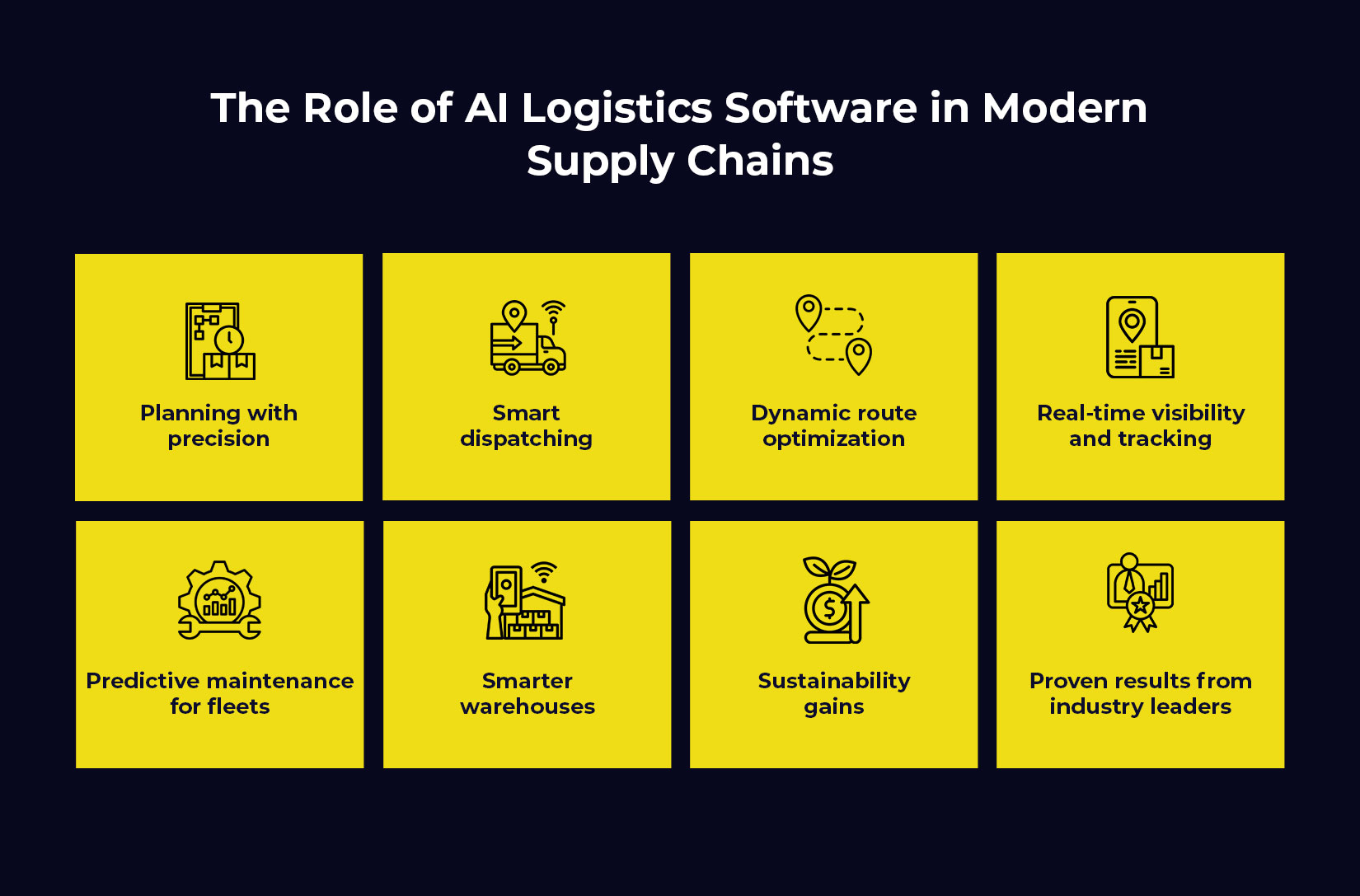
From Planning to Delivery: Why AI-Based Logistics Tech is the Future
Logistics now is less truck, more tech. As companies navigate shrinking delivery windows, soaring costs, and customer demands that continue to rise, conventional logistics systems are lagging. Step in AI logistics software, a disruptor force making every movement of the supply chain a brilliant, data-driven process.
From dynamic route optimization to predictive demand planning, AI-powered logistics software is not only the future, it’s already shaping the future.
Why the Logistics Industry Needs a Tech Makeover
Let’s be real, manual workflows, spreadsheets, and siloed systems are slow-downs. In a 2025 report, McKinsey said that organizations that integrate AI into logistics save up to 15% on operational expenses. They also increase delivery speed by 35%.
As eCommerce grows globally and delivery expectations narrow, logistics companies are racing to remain efficient. What they require is accuracy, velocity, and adaptability. And that is precisely what AI-powered logistics software offers.
What is AI Logistics Software?
AI logistics software is a system that leverages artificial intelligence, machine learning, and predictive analysis to streamline logistics processes. These include:
– Route planning and optimization
– Warehouse automation
– Demand forecasting
– Real-time tracking of deliveries
– Predictive fleet maintenance
– Automated dispatch and carrier selection
Unlike legacy systems, an AI logistics system continuously learns and improves, enabling businesses to make smarter decisions based on real-time data.
The Role of AI Logistics Software in Modern Supply Chains

1. Planning with Precision:
Perhaps the greatest benefit of AI logistics software is that it can accurately predict demand. Historical data, current market conditions, weather, and even social media buzz are analyzed by AI models to predict spikes or dips in demand across regions. This prevents overstocking, understocking, and wastage of resources. Gartner suggests AI-driven demand forecasting can enhance inventory accuracy by as much as 50%,enabling companies to significantly reduce carrying costs.
2. Smart Dispatching:
Manual dispatching is time-consuming and prone to errors. AI-powered logistics software makes dispatching a data-driven process. It considers delivery priority, driver availability, proximity, vehicle type, and traffic to real-time assign jobs. It can also re-route or reassign deliveries dynamically in case of disruption. This results in reduced delays, improved driver utilization, and better SLA compliance.
3. Dynamic Route Optimization:
AI doesn’t quit after the parcel goes out for delivery. A logistics software powered by AI keeps recalculating the optimal delivery route through real-time data, i.e., traffic congestion, weather notices, roadblocks, and customers’ preferences. This translates to fewer miles wasted, reduced fuel burn, and speedier deliveries. Accenture estimates that dynamic route optimization driven by AI can lower fuel consumption by 10-20%. Also boost the number of deliveries per day by 15%.
4. Real-Time Visibility and Tracking:
Customers demand visibility. Customers want to see, down to the minute, exactly where their order is and when they can expect it to arrive. With an interconnected AI logistics system, both customers and operations managers achieve real-time visibility into vehicle locations, delivery status, and estimated arrival times. Transparency improves customer satisfaction and lightens the burden on support staff answering “Where’s my order?” calls.
5. Fleet Predictive Maintenance:
Breakdowns are costly, both to repair and in lost service time. With the use of IoT sensors and AI-powered logistics software, companies can anticipate when a vehicle part will fail and schedule a proactive maintenance. This results in reducing unplanned downtime by as much as 50% and increasing the overall life of fleet assets.
6. Smarter Warehouses:
The advantages of AI-powered logistics software are not confined to roads. In the warehouse, AI streamlines inventory management, maps out optimal picking routes, minimizes errors, and maximizes space use. AI vision systems have the ability to identify faulty goods, and algorithms can forecast when to stock up, avoiding overstocking and stockouts.
7. Sustainability Benefits:
In addition to efficiency, AI also benefits the environment. More efficient routing lowers emissions. Optimized loads equate to fewer trips. Predictive maintenance reduces waste. Together, AI logistics software allows logistics operations to save carbon while delivering better performance.
8. Proven Results from Market Leaders:
Industry leaders are already at the forefront. Amazon leverages AI to drive its entire logistics network, robotic fulfillment centers to last-mile delivery forecasting. DHL saw a 25% increase in productivity following the introduction of AI solutions for route planning and workforce optimization. Maersk depends on AI to offer better visibility and international shipping route optimization.
Case in Point: Brands Already Winning with AI Logistics
World leaders such as Amazon, DHL, and Maersk are investing big in logistics software driven by AI to stay ahead of the competition.
– Amazon employs AI for warehouse robots, forecasting demand, and last-mile delivery.
– DHL has recorded a 25% boost in efficiency after adopting AI tools.
– Maersk uses AI for supply chain visibility and ocean route optimization.
The word is out: companies that do not embrace AI will be left behind.
Challenges, But the ROI Speaks
Yes, implementing AI logistics software comes with challenges, upfront cost, integration of the system, and managing change. But the return on investment is not debatable.
– Reduced delivery times
– Reduced fuel expenses
– Improved order accuracy
– Increased customer satisfaction
– Guarantees green operations
With AI, these systems become increasingly available and scalable to mid-sized and even smaller organizations as AI continues to evolve.
Conclusion
AI logistics software is not a choice anymore, it’s the competitive edge that today’s supply chains require. From predictive planning to real-time execution of deliveries, the move towards the logistics software is transforming the sector.
So if you’re still mired in the past, it’s time to go forward. The future of logistics is investing in the best AI powered logistics software. So, click on the red button below and book a demo with LogiNext Solutions today.
11







@LogiNext